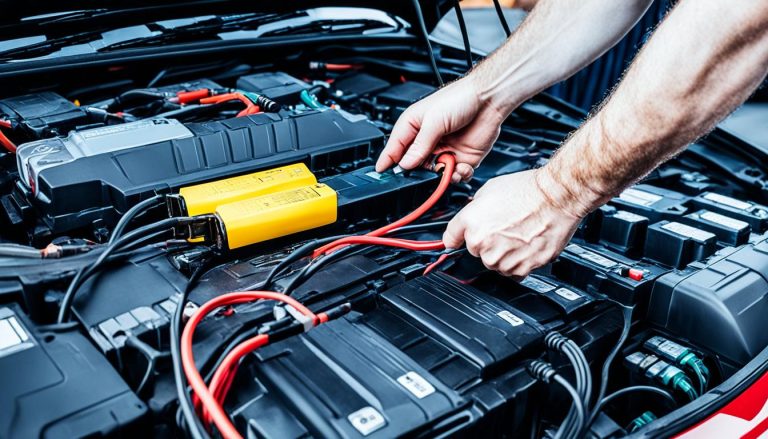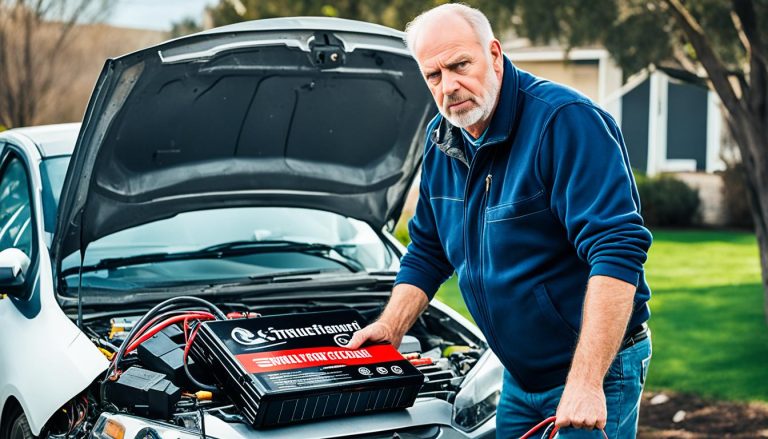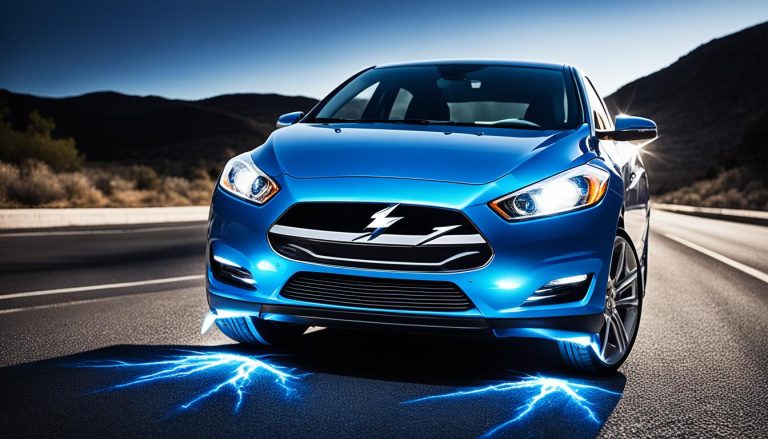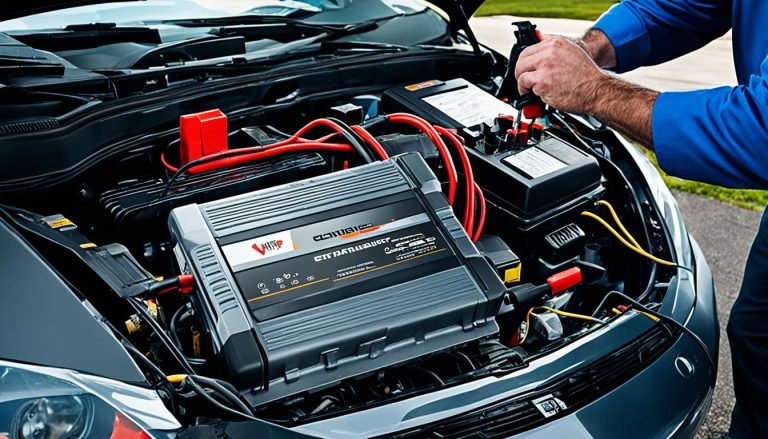Type S Jump Starter: Decoding Battery Protected Alert
batterychargers.site and its partners may earn a commission if you purchase a product through one of our links
Have you ever encountered a ‘battery protected’ message on your Type S Jump Starter? This notification is not only a sign of advanced technology at work but also an indication of your device’s commitment to safety. The Type S Jump Starter is more than a convenient accessory; it’s a lifeline when you’re faced with a depleted battery. With its smart sensors and internal lithium-ion battery pack, it ensures a worry-free jump start by preventing reverse polarity mistakes and overcharging—a testament to its intelligent design.
Understanding what triggers a protected message on your jump starter battery can be essential in maintaining both your vehicle’s and the jump starter’s longevity. Technological safeguards embedded within your Type S device are engineered to ensure that even if you’re in a rush, your safety and that of your vehicle’s electrical system are not compromised.
Key Takeaways
- Type S Jump Starter integrates safety features to prevent battery and vehicle damage.
- A ‘battery protected’ alert indicates a safety mechanism has been triggered to preserve your jump starter battery.
- Sensors within your Type S device actively monitor connections to prevent common jump-starting errors.
- Proper usage and awareness of the alert system can significantly increase the longevity of your Type S battery.
- By adhering to the device’s safety protocols, you can ensure a secure and efficient energy transfer every time you need a jump start.
Understanding the Type S Jump Starter Battery Protected Message
When you’re dealing with dead vehicle batteries, the last thing you want is a complicated jump-starting process. Fortunately, the Type S Jump Starter simplifies this task while prioritizing user safety with its battery protected message feature. Let’s delve into why this feature is not just an add-on but a critical component of the Type S Jump Starter’s operation.
The Importance of the Battery Protection Feature
Imagine attempting to jump-start your car only to be greeted by a battery protected message. This alert serves as a vital warning, indicating that your Type S Jump Starter’s intelligent systems are actively preventing potential damage to your vehicle or the jump starter itself. This protection springs into action thanks to a synergistic safety system involving several critical components.
How the Protection Circuit Prevents Damage
The protection circuit is your assurance that every jump start will be a safe one. At the heart of this system lies a sophisticated microcontroller, which constantly monitors the state of the jump starter’s connection to your vehicle’s battery. A vehicle battery isolation sensor, along with a reverse polarity sensor, feeds crucial information to the microcontroller, ensuring that everything is connected properly before any power is transferred.
Should the microcontroller receive sensors’ input signaling an incorrect polarity or an absence of a battery connection, the power FET switch will remain off. This preemptive approach is key to avoiding electrical mishaps, such as overcharging or short-circuiting—common concerns that can lead to severe damage or even accidents.
| Component | Function | Role in Battery Protection |
|---|---|---|
| Vehicle Battery Isolation Sensor | Detects proper connection to battery | Ensures the battery is ready and able to receive charge |
| Reverse Polarity Sensor | Identifies incorrect terminal connections | Prevents reversing of power flow, which can cause damage |
| Power FET Switch | Controls the flow of electricity | Only allows power to flow when safe to do so |
| Microcontroller | Manages input from sensors and controls the circuit | Acts as the brain of the system to ensure overall safety |
The type S jump starter battery protected message is, in essence, a guardian against electrical adversities. Understanding this message and the intricate workings of the protection circuit can give you peace of mind knowing that your Type S Jump Starter won’t just get your vehicle running—it will do so with your safety as the top priority.
Common Triggers for the Type S Battery Protected Alert
When you encounter a battery protected alert on your Type S jump starter battery, it’s signaling that something may be amiss with your car’s electrical system. Understanding the common triggers for this alert ensures that you maintain battery protection while preventing potential car electrical system malfunctions.
Among the usual culprits, a poor ground connection can disrupt the current flow and prompt the alert system. Equally problematic are scenarios where extreme temperature effects come into play, influencing your battery’s performance and chemical balance. To dive deeper, let’s look at some specific triggers:
- Short circuit due to clamps touching
- Excessive current suggesting potential overheating
- Reverse connection of terminals
- Voltage irregularity, hinting at open circuits or solenoid issues
It’s not just internal issues that can cause trouble. External factors such as the environment can lead to the jump starter battery protection being activated. Here’s what to keep an eye out for:
Remember, your Type S jump starter battery is designed to ensure your safety and the optimal functioning of your vehicle. Taking heed of the protection alert can spare you from future inconveniences and costly repairs.
Here’s a quick reference table outlining potential triggers and their effects:
| Trigger | Potential Effect |
|---|---|
| Poor Ground Connection | Erratic behavior of electrical components |
| Extreme Temperature Effects | Reduced battery efficiency and lifespan |
| Car Electrical System Malfunctions | False alarms or actual system failures |
While some triggers are immediately noticeable, others may take a while to detect. It’s always best to check that your jump starter battery is in good condition and that your car’s electrical system is free of any malfunctions. If your Type S jump starter regularly displays a protected alert, consider a thorough inspection to ensure connections are solid, and your vehicle is not experiencing any undue stress due to environmental extremes.

Regular maintenance and awareness of these common triggers will help you better manage your jump starter battery’s lifecycle and provide assurance that battery protection is functioning as intended.
Step-by-Step Guide: Responding to Your Jump Starter’s Alerts
When your trusty Type S jump starter battery signals an alert, it’s not just a notification—it’s a call to action ensuring your safety and the longevity of your jump starter. Follow this comprehensive guide to efficiently respond to these alerts and get back on the road with confidence.
Assessing the Battery Status
Start by checking the battery status to determine if the alert is indicating a discharge or if it’s merely a low charge warning. A quick assessment can inform you whether a simple recharging session is needed or if a deeper issue with your battery exists that requires attention.
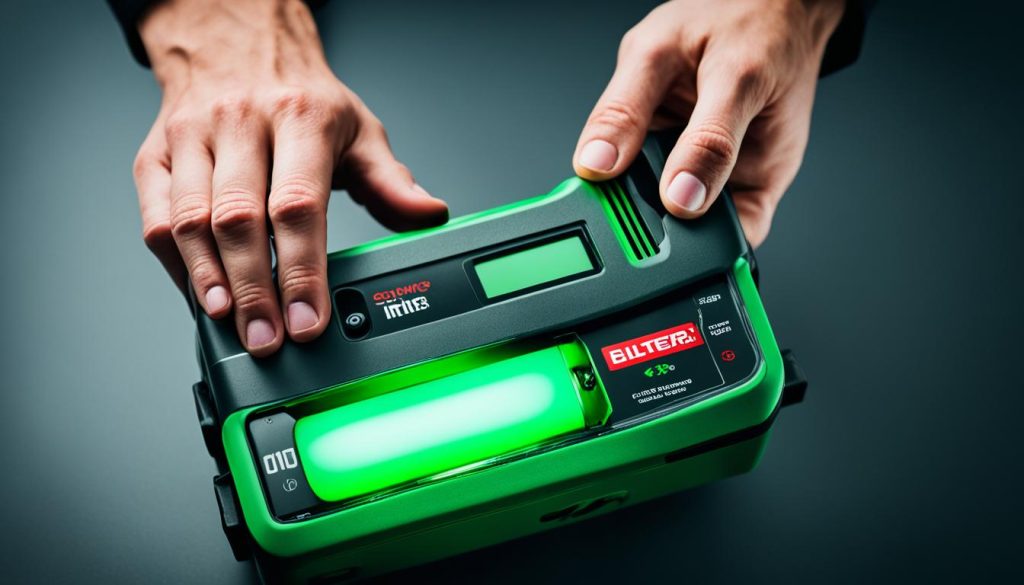
Resolving Connection Issues
Proper connections are essential for an effective jump start. Examine the clamps and ensure they are securely fastened to the correct battery terminals. Look for any signs of corrosion and clean the contacts if necessary. Addressing these connection issues can often resolve the alerts immediately and ensures a safe and successful jump start.
Recharging Your Type S Jump Starter Battery
If your jump starter battery itself is low on power, it’s imperative to recharge it properly. Use the specified charger designed for your Type S model or jump-start it using a fully charged battery from another vehicle—just be sure to follow all safety protocols. Keeping your recharging type S jump starter battery method up to par will help you avoid future alerts and extend the life of your jump starter.
Troubleshooting Tips for Type S Jump Starter Battery Issues
Dealing with a Type S jump starter that just won’t work can be frustrating, especially when you’re facing a flat battery situation. Before you let worry set in, let’s dive into some tried and tested troubleshooting techniques. There can be various reasons why your jump starter isn’t functioning as expected, and understanding the nuances between different warnings can save you time and possibly prevent unnecessary expenses.
Identifying False Alarms
A false alarm can have you scrambling for no reason. Sometimes, what seems like a malfunction may be a simple user error or a minor issue that you can rectify yourself. Start by checking the warning lights and ensuring you’re interpreting them correctly. Do a once-over on all your connections — a loose clamp or a poor ground can trigger an alert that mimics a more serious problem. Remember, troubleshooting your Type S jump starter can often reveal that the alarming signal is just a hiccup waiting to be sorted out.
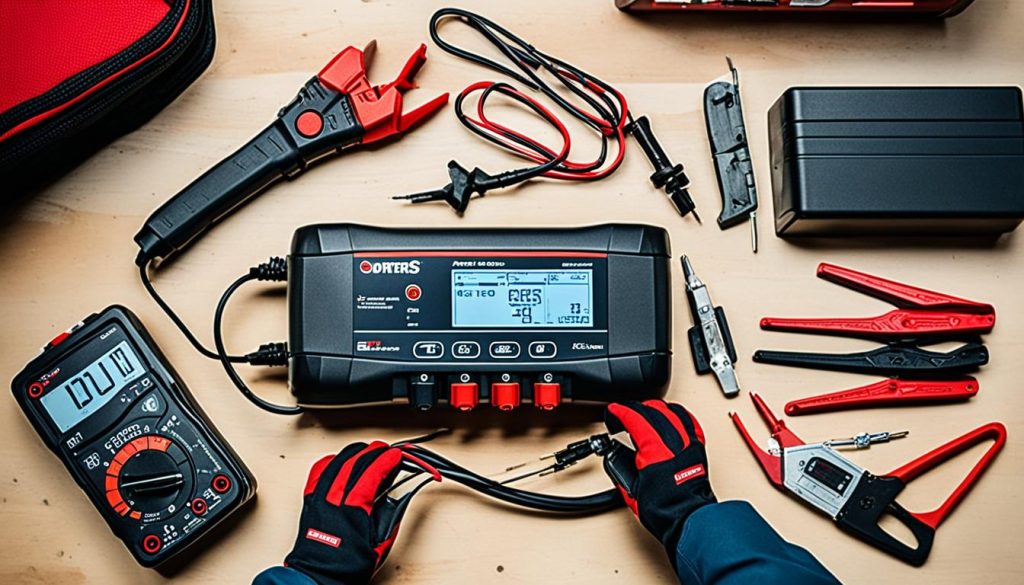
When to Seek Professional Help
If your troubleshooting efforts haven’t borne fruit and your jump starter is still sending out SOS signals, it might be time to seek professional help with your jump starter. Persistent problems could indicate deeper electrical issues that require a mechanic’s expertise. Here is a handy table to help you decide when to call in the pros:
| Issue | Troubleshooting Step | Outcome | Action |
|---|---|---|---|
| Alert won’t clear after checking connections | Re-evaluate connections and test battery | Issue persists | Seek professional diagnostic |
| Jump Starter not charging | Test with different charger/cable | No charge | Professional repair or replacement |
| Warning lights flashing abnormally | Consult the manual for error codes | Unclear resolution | Professional electrical checkup |
In cases where these steps don’t provide clarity, a mechanic will delve into the vehicle’s electrical system, checking everything from the alternator to the individual ground connections. Taking this step ensures that your issue is resolved safely and thoroughly, with an expert hand guiding the process.
Technical Insights: How Your Type S Jump Starter Detects Polarity

Imagine you’re in a rush, you get to your car and realize your battery is dead. You have your trusty Type S jump starter at hand, but in the stress of the moment, there’s a chance you might accidentally reverse the cables. This could lead to serious consequences, but not to worry! Your Type S has a smart feature to detect polarity, ensuring you’re safe from a potential battery explosion risk.
How does it establish correct polarity before attempting a jump start? Through a methodical process of voltage monitoring and current delivery checks. Should an error in connection occur, the system identifies this in milliseconds, preventing the flow of current and thus averting any imminent risks to you and your vehicle’s battery.
| Feature | Function | Benefit |
|---|---|---|
| Voltage Monitoring | Determines the status of the vehicle’s battery. | Prevents discharge if the battery is improperly connected. |
| Reverse Polarity Sensor | Detects incorrect cable connections. | Avoids potential short circuits and electrical hazards. |
| Smart Technology | Assesses the current’s pathway before delivery. | Ensures a secure jump start, reducing explosion risks. |
This level of attention to detail in the design of the Type S jump starter ensures that you, as the user, can confidently use the device under any circumstance. It’s a perfect example of technology that not only advances functionality but also safety and convenience, so you can resume your journey without worries.
Maintaining Your Type S Battery for Optimal Longevity
Ensuring the enduring health and efficiency of your Type S battery doesn’t have to be challenging. With the right caring routine, you can significantly extend the lifespan and reliability of this critical component in your vehicle’s emergency kit. By focusing on **effective charging practices** and **preventative battery health measures**, you maintain not just a battery but a lifeline for those moments when your car needs a jump start the most.
Effective Charging Practices
To maintain your Type S jump starter battery, it’s crucial to adopt charging practices that contribute to **optimal longevity**. This involves keeping the battery regularly charged and not letting it dip into a deep discharge state, which can be harmful over time. Ensure you’re charging your jump starter according to the manufacturer’s guidelines. Incorrect charging can not only affect the performance but also impact the overall lifespan of your jump starter.
Preventative Measures for Battery Health
In addition to charging correctly, implementing **preventative battery health measures** is paramount. Routine check-ups are not just about observing current battery status but anticipating future needs to avoid unexpected failures. Operating your Type S battery within the recommended temperature parameters is also essential as it prevents the adverse effects of extreme temperatures on the internal chemical reactions, thereby preserving the unit’s integrity. Remember, a well-maintained battery is one that won’t let you down when you need it most. By adhering to these simple yet effective steps, you ensure your Type S remains a trusted ally in jump-starting your vehicle.
FAQ
What does a “battery protected” message mean on my Type S Jump Starter?
When you see a “battery protected” message, your Type S Jump Starter has detected an issue such as incorrect polarity, no battery connection, possible short circuit, or an unsafe condition preventing it from delivering charge to avoid damage to your vehicle or the jump starter itself.
Why is the battery protection feature important in a jump starter?
The battery protection feature is crucial for ensuring safety when jump-starting your vehicle. It safeguards against potential electrical damage that can occur from improper connections, overcharging, or reverse polarity, thereby protecting you, your vehicle, and the jump starter.
What are the common triggers that activate the Type S battery protected alert?
The alert can be triggered by various issues, including short circuits, excessive current flow, reversed terminal connections, voltage irregularities, and aged batteries. It also detects malfunctions in the vehicle’s electrical system, poor ground connections, and extreme temperature impacts on battery performance.
How should I respond to a protection alert from my Type S Jump Starter?
Start by checking and confirming the battery’s status and connections. Make sure the clamps are correctly attached and the contacts are clean and secure. If the issue persists, recharge your Type S Jump Starter and minimize electrical accessory usage until the problem is resolved. If necessary, consult a professional for further diagnostics.
What should I do if my Type S Jump Starter keeps showing a battery protected alert?
Begin by troubleshooting with the steps provided above. If the protection alert continues, it’s time to seek help from a professional who can undertake a comprehensive check of your vehicle’s electrical system and remedy any underlying issues.
How does the Type S Jump Starter detect incorrect battery polarity?
The Type S Jump Starter is equipped with polarity sensors and advanced technology that monitor voltage and assess current delivery. If a reverse connection is detected, the jump starter prevents power flow to avoid damage to both the battery and the device itself.
What are some best practices for maintaining my Type S battery?
To maintain optimal longevity for your Type S battery, regularly charge it correctly and avoid over-discharging. Also, carry out periodic battery check-ups and operate the battery within recommended temperature ranges to prevent harm from extreme conditions.


